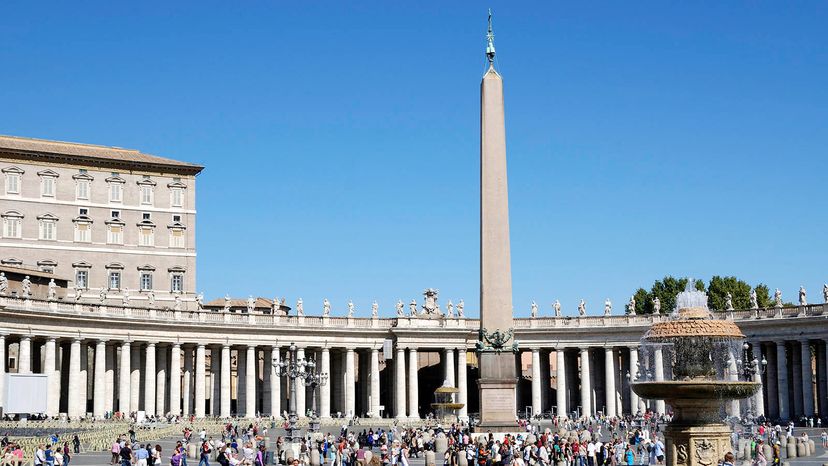The fact that these original structures were monolithic — meaning they were carved from one single piece of stone — makes them distinct from more modern variations. "Many people don't realize that the ancient Egyptian obelisk was a monolith," Long says. "This is one thing that makes them beautiful and remarkable. There are obelisk-shaped masonry structures such as the Washington Monument in Washington, D.C., but of course, they differ from the ancient Egyptian monolithic structures."
According to experts, obelisks were often associated with the ancient Egyptian sun god, Ra. But their meaning may go even deeper. "The obelisk is a solar symbol of regeneration and creation, and it symbolizes the Benben stone," Vicky Almansa-Villatoro, Ph.D. candidate in Egyptology at Brown University, says via email. "What is the Benben stone? According to the ancient Egyptian myths of creation ('cosmogonies'), in the beginning, there was a primordial ocean of nothingness called Nu. Among these cosmogonies, the Heliopolitan account describes how the first thing to ever arise from these waters was a mound of earth — the so-called Primordial Hill. This mound is clearly inspired by the fertile hills that emerged from the waters of the Nile every year after the annual flood began to recede and the crop-growing season approached. The Benben is actually the icon, the magical representation of the Primordial Hill."

According to Almansa-Villatoro, the Benben was likely an actual mound-shaped monument that residents of Heliopolis worshipped. "The Sun temples of the Fifth Dynasty incorporated a mound of earth resembling a small pyramid in their courtyards, and likewise, obelisks are topped by a small pyramidion," she says. "Thus, both the obelisks and the pyramids are regenerative icons and rooted in the symbolism of the Primordial Hill and the Benben stone. The Egyptian myths of the creation are multiple and sometimes contradictory. The myth that incorporates the Primordial Hill, and thus the Benben, is the Heliopolitan myth. Heliopolis was the city of worship of the sun god Ra and his many manifestations."
One significant feature found on many of the original obelisks is their decorative flair. "Obelisks were often ornamented on all four sides with hieroglyphic writing, which for the most part, commemorated the pharaoh and his or her deeds," Long says. "The fascination with obelisks has led to many studies by Egyptologists about their construction, transport, erection and ultimate meaning. As scholars in the modern world have studied their hieroglyphs (inscribed on most, but not all, obelisks), and their architectural and cultural context, they have learned much about the ancient obelisks."
But one thing many of us may not consider when it comes to objects weighing in at several hundred tons is that they can, in fact, migrate (with the help of human hands, that is). "It's also true that obelisks are ancient monuments that can be moved — so their meaning has changed as they are moved from one location (and culture) to another," Long says. "The obelisks in Egypt, Rome, Istanbul, Paris, London and New York, all have meant very different things to the people and culture that possess them — very different from that of the ancient Egyptians."
While the honor of the world's tallest obelisk belongs to the Washington Monument (standing 555 feet, or 169 meters, tall), Long believes the most famous obelisk on the planet is likely the Vatican Obelisk at the center of Rome's St. Peter's Square. "It's famous because of the renown it acquired — not when it was brought by the ancient Romans from Egypt to Rome after the Roman conquest of Egypt — but when Pope Sixtus V and his engineer, Domenico Fontana, moved the obelisk from the side of St. Peter's to the front where it now stands," she says. "This occurred in a dramatic series of steps with all of Rome watching in the spring, summer and early fall of 1586."

Long says the dramatic transport process was fraught with danger and celebrated all around Italy when it was accomplished. "The engineer, Domenico Fontana, wrote a wonderful book with spectacularly detailed woodcuts explaining every step of the move including all the men and machinery that were used," she says. "This account was published in 1590. We can marvel at it today both because of Fontana's lucid explanations and the illuminating illustrations showing the steps and the machinery used for the move."
While obelisks are rich in meaning and historical significance, their main attraction may really be their awe-inspiring aesthetics. "Obelisks are beautiful," Long says. "If you are ever in Egypt, Istanbul, Rome, Paris, London or New York, stop to really look at the obelisks. They are immensely heavy, but also fragile. They are the oldest or among the oldest human-made structures that exist in whichever city you find them. They display a subtle geometry. Block out the traffic noise, and other distractions, and spend some time looking at the obelisk, walking around it (if you can), observing the hieroglyphs, the pyramidion pointing to the sun. Immensely heavy monuments that are also transportable, they connect us to an ancient past, but can be deeply moving in the present as well."
Now That's Ancient
The oldest man-made object in Central Park and the oldest outdoor monument in New York City is the obelisk known as “Cleopatra's Needle.” It's over 3,000 years old, stands 69 feet high and weighs an amazing 220 tons. It was erected in Central Park on January 22, 1881, after having been sold to the United States by the Egyptian government.
Advertisem*nt